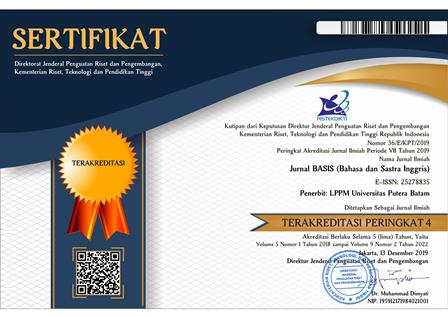CODE MIXING ANALYSIS IN DIVORTIARE NOVEL
DOI:
https://doi.org/10.33884/basisupb.v9i2.5512Abstrak
This research aimed to analyze the usage of code mixing in Divortiare novel that was written by Ika Natasssa. The objective of this research is to find out the type of code mixing that is used in Divortiare Novel. This study is a qualitative research. The technique of collecting data was done by using documentary technique. The odd number chapters in Divortiare novel are used as the data of this study. The data were analyzed by using Miles and Hubberman model. The findings of this study show that there are three types of code mixing used namely: insertion, congruent lexicalization and alternation. The result of this study showed that insertion was used 71,75%; congruent lexicalization was used 21,08% and alternation was used 7,17%. Based on the result of this study, it shows that the most dominant type of code mixing used in Divortiare novel is insertion. So, it can be concluded that the writer of the novel use insertion most dominantly cause discuss about particular topic, being emphatic about something and expressing group identity.
Referensi
Adrean, Muhammad Ricky., Daud, Bukhari., & Kismullah. 2019. An Analysis of Code Mixing in Indonesian Movie Cek Toko Sebelah. Research in English and Education Journal, 4(4), page 147-154, December 2019.
Creswell, J. W. 2001. Research Design Qualitative and Quantitative Approaches. London: Sage Publications.
Chambers, J. K. , Trudgill, P. & Schilling-Estes, N. 2002. The Handbook of Language Variation and Change. Oxford: Blackwell.
Chaer, Abdul & Leonie Agustina. 2004. Sosiolinguistik Perkenalan Awal. Jakarta: Rineka Cipta.
Chaer, Abdul. 2007. Linguistik Umum. Jakarta: Rineka Cipta.
Hoffman, Charlotte. 1991. An Introduction to Sociolinguistics. London: Longman.
Holmes, Janet. 2001. An Introduction to Sociolinguistics. New York: Longman.
Holmes, J. 2013. An Introduction to Sociolinguistics, Fourth Edition. New York: Routledge.
Jendra, Made Iwan Indrawan. 2010. Sociolinguistics: The Study of Societies Language. Yogyakarta: Graha Ilmu.
Manik, Sondang. 2013. Code Switching and Code Mixing on Lawyers Club’s Talk Show: A Live Show on TV ONE. Jurnal Linguistik Asia-Pasifik, Volume 6 June – December, Singapore Multisynchronic Publisher.
Miles, Matthew B, Huberman, Michael A & Saldana, J. 2014. Qualitative Data Analysis. California: SAGE Publications.
Muliana, Rahmi Sri & Mubarak, Zia Hisni. 2022. Code Switching Used by Chef Juna On Deddy Corbuzier Podcast. Journal Basis, Vol. 9. No. 1 April 2022. Retrieved from https://ejournal.upbatam.ac.id/index.php/basis/article/view/4535/2550
Muljayanti, E. 2017. The Indonesian-English Code Mixing in Just Alvin Show at Metro TV. Journal of English Language and Culture, Vol. 7 page 57-53.
Muysken, Pieter. 2000. Bilingual Speech: A Typology of Code Mixing. Cambridge: Cambridge University Press.
Myers Scotton, C. 2001. The Matrix Language Frame Model: Development and Responses. Code Switching Worldwide II. Berlin: Mouton de Gruyter.
Nababan, P.W.J. 1993. Sosiolinguistik: Suatu Pengantar. Jakarta: Gramedia Pustaka Utama.
Ohoiwutun, Paul. 2007. Sosiolinguistik: Suatu Pengantar. Jakarta: Gramedia Pustaka Utama.
Romaine, S. 2000. Language in Society An Introduction to Sociolinguistics. New York: Oxford University Press.
Syafrizal & Sari, A.R. 2017. Code Mixing in Students’ Twitter Status at Sultan Ageng Tirtayasa University in Banten, Indonesia. European Journal of Foreign Language Teaching. 2 (1) Page 117-134.
Syafryadin & Haryani. 2020. An Analysis of English Code Mixing Used in Indonesian Magazine. Journal of Languages and Language Teaching, Vol. 8 No. 4 Page 381-390, October 2020.
Wardaugh, R., & Fuller, J. 2015. An Introduction to Sociolinguistics, Seventh Edition. United Kingdom: John Wiley & Sons, Inc.













 JURNAL BASIS (BAHASA DAN SASTRA INGGRIS)
JURNAL BASIS (BAHASA DAN SASTRA INGGRIS)
